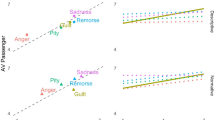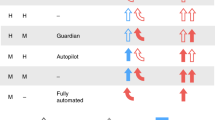Abstract
Autonomous vehicles (AV) promise a reduction in the number of deadly traffic accidents. However, should accidents occur, attributions of responsibility are complicated by the fact that there is a human agent (driver) and a non-human agent (AV), and thus responsibility is likely shared between parties. In two studies, participants (n = 310 and n = 260) read a vignette modeled after an actual lethal AV accident. Across four experimental conditions, participants were told that the human driver either needed to maintain oversight of the AV; did not need to maintain oversight of the AV; did not specify whether the human needed to maintain oversight of the AV; or the artificial intelligence was turned off and the human driver was fully in control. Participants assigned responsibility to the human driver, the AV company, the pedestrian, and an act of God, and determined whether the human driver and company CEO should be held criminally responsible in court. Consistent with previous research, the human driver was held most responsible regardless of oversight condition. However, companies were not absolved of responsibility, even when they required the human driver to maintain oversight of the AV. Implications of these findings for the introduction and legal regulation of AVs are discussed.


Similar content being viewed by others
Data Availability
The data for the two studies reported in this paper are available at the Open Science Foundation: https://osf.io/x4wp2/?view_only=bd7d059563804f43b35882b3d64b9dd4
Notes
Beyond humans, agency also tends to be attributed to deities or beings such as spirits, totems etc. Typically, such beings are represented in ways that attribute human characteristics to them.
McManus and Rutchik (2019) also tested to what extent the availability of an override switch shaped blame attributions. If the human owner could have overridden the actions of the AV, the driver was not blamed any more or less compared to when he was operating a manual vehicle. However, more blame was assigned when the driver did override the actions of the vehicle. The latter finding highlighted commission as a critical element in blame attributions.
The only way for the vehicle to “intervene” would have been for it to notify the driver (Vasquez) because the automated brake function had been disabled.
The present research was conducted in Spring of 2020, when Rafaela Vasquez had not been charged yet, and when it appeared that she would not be charged. The present research was inspired in part by the question of why she had not been charged, even when existing research suggested that the human driver would be most likely identified as the party most responsible.
The present studies also explored various moderator variables, including self-reported knowledge of and attitudes toward AVs, as well as political orientation, as existing research suggests that conservatives tend to be more pro-business (e.g., Heinze et al., 2014), and are more likely than liberals to embrace an ideology of personal responsibility (Carroll et al., 1987; Schlenker et al., 2012). However, none of the variables yielded reliable and consistent effects across our two studies; hence, they are not reported further.
Some conditions in our study do correspond to specific automation levels as stipulated by the Society of Automotive Engineers (SAE). Our “AI not engaged” condition corresponds to level 0 (no automation). Our “oversight not required” condition suggests level 5 (human attention not required). Our “oversight required” leaves it open if this is level 3 or 4 (both require human interaction in case of error or system failure).
In both studies reported here, participants also responded to questions pertaining to monetary liability, and knowledge and trust of autonomous vehicles, and trust in technology in general. These variables were either considered problematic or did not yield any meaningful results. Additional information about these findings can be obtained from the authors.
The exact wording of the revised item was “No one is to blame for the accident, (i.e. this was an ‘act of God’).”
Overall, in spite of the slightly different online questionnaire design and the varying order of measures, means for the responsibility ratings were indistinguishable between Study 1 and Study 2. The only exception were the driver responsibility ratings, which were significantly higher in Study 1 than in Study 2 (ΔM = 8.47, 95%CI [4.11, 12.83]).
References
Alicke, M. D. (2000). Culpable control and the psychology of blame. Psychological Bulletin, 126(4), 556–574.
Arizona’s Executive Order 9, 2015, or). https://apps.azdot.gov/files/sitefinity-files/Executive-Order-2015-09.pdf
Awad, E., Levine, S., Kleiman-Weiner, M., Dsouza, S., Tenenbaum, J. B., Shariff, A., Bonnefon, J. F., & Rahwan, I. (2020). Drivers are blamed more than their automated cars when both make mistakes. Nature Human Behaviour, 4(2), 134–143.
Bates, D., Maechler, M., Bolker, B., & Walker, S. (2015). Fitting linear mixed-effects models using lme4. Journal of Statistical Software, 67, 1–48.
BBC News. (2019, November 6). Uber in fatal crash had safety flaws say US investigators. . Retrieved from https://www.bbc.com/news/business-50312340
Bennett, J. M., Challinor, K. L., Modesto, O., & Prabhakharan, P. (2020). Attribution of blame of crash causation across varying levels of vehicle automation. Safety Science, 132, 1–12. https://doi.org/10.1016/j.ssci.2020.104968.
Bonnefon, J. F., Shariff, A., & Rahwan, I. (2016). The social dilemma of autonomous vehicles. Science, 352(6293), 1573–1576. https://doi.org/10.1126/science.aaf2654.
Carroll, J. S., Perkowitz, W. T., Lurigio, A. J., & Weaver, F. M. (1987). Sentencing goals, causal attributions, ideology, and personality. Journal of Personality and Social Psychology, 52, 107–118. https://doi.org/10.1037/0022-3514.52.1.107.
De Freitas, J., Anthony, S. E., Censi, A., & Alvarez, G. A. (2020). Doubting driverless dilemmas. Perspectives on Psychological Science, 15(5), 1284–1288. https://doi.org/10.1177/1745691620922201.
Elish, M. C. (2019). Moral crumple zones: Cautionary tales in human-robot interaction. Engaging Science, Technology, and Society, 5, 40–60.
Elish, M. C. (2020, June 15). Who is responsible when autonomous systems fail? Centre for international governance innovation. Retrieved from https://www.cigionline.org/articles/who-responsible-when-autonomous-systems-fail
Foot, P. (1967). The problem of abortion and the doctrine of double effect. Oxford Review, 5, 5–15.
Gonzales, R. (2019, November 7). Feds say self-driving Uber SUV did not recognize jaywalking pedestrian in fatal crash. NPR. Retrieved from https://www.npr.org/2019/11/07/777438412/feds-say-self-driving-uber-suv-did-not-recognize-jaywalking-pedestrian-in-fatal-.
Hans, V. P. (2000). Business on trial. Yale University Press.
Heinze, J., Uhlmann, E. L., & Diermeier, D. (2014). Unlikely allies: Credibility transfer during a corporate crisis. Journal of Applied Social Psychology, 44, 392–397. https://doi.org/10.1111/jasp.12227.
Hilton, D. J., McClure, J., & Sutton, R. M. (2010). Selecting explanations from causal chains: Do statistical principles explain preferences for voluntary causes? European Journal of Social Psychology, 40(3), 383–400.
Hilton, D. J., McClure, J., & Moir, B. (2016). Acting knowingly: Effects of the agent's awareness of an opportunity on causal attributions. Thinking & Reasoning, 22(4), 461–494.
Lagnado, D. A., & Channon, S. (2008). Judgments of cause and blame: The effects of intentionality and foreseeability. Cognition, 108(3), 754–770. https://doi.org/10.1016/j.cognition.2008.06.009.
Li, J., Zhao, X., Cho, M., Ju, W., & Malle, B. (2016). From trolley to autonomous vehicle: Perceptions of responsibility and moral norms in traffic incidents with self-driving cars. Paper presented at the Society of Automotive Engineers World Congress, Detroit, MI. https://doi.org/10.4271/2016-01-0164.
Liu, M., & Conrad, F. G. (2019). Where should I start? On default values for slider questions in web surveys. Social Science Computer Review, 37(2), 248–269.
MacCoun, R. J. (1996). Differential treatment of corporate defendants by juries: An examination of the" deep-pockets" hypothesis. Law and Society Review, 30, 121–161.
McCausland, P. (2019, November 9). Self-driving Uber car that hit and killed woman did not recognize that pedestrians jaywalk. NBC News. Retrieved from https://www.nbcnews.com/tech/tech-news/self-driving-uber-car-hit-killed-woman-did-not-recognize-n1079281
McManus, R. M., & Rutchick, A. M. (2019). Autonomous vehicles and the attribution of moral responsibility. Social Psychological and Personality Science, 10(3), 345–352.
National Highway Traffic Safety Administration (2015, February). Critical reasons for crashes investigated in the national motor vehicle crash causation survey. https://crashstats.nhtsa.dot.gov/Api/Public/ViewPublication/812115
National Safety Council. (2020). Motor vehicle deaths estimated to have dropped 2% in 2019. https://www.nsc.org/road-safety/safety-topics/fatality-estimates
National Transport Commission (2020). Automated vehicle program approach. https://www.ntc.gov.au/sites/default/files/assets/files/Automated%20vehicle%20approach.pdf
Nevada Revised Statue 482A. https://www.leg.state.nv.us/NRS/NRS-482A.html
Pöllänen, E., Read, G. J. M., Lane, B. R., Thompson, J., & Salmon, P. M. (2020). Who is to blame for crashes involving autonomous vehicles? Exploring blame attribution across the road transport system. Ergonomics, 63(5), 525–537. https://doi.org/10.1080/00140139.2020.1744064.
Randazzo, R. (2019, March 17). Uber crash death in Tempe: A closer look. AZ Central. Retrieved from https://www.azcentral.com/story/news/local/tempe/2019/03/17/uber-crash-death-who-blame-tempe-arizona-rafaela-vasquez-elaine-herzberg/3157481002/
Schlenker, B. R., Chambers, J. R., & Le, B. M. (2012). Conservatives are happier than liberals, but why? Political ideology, personality, and life satisfaction. Journal of Research in Personality, 46(2), 127–146. https://doi.org/10.1016/j.jrp.2011.12.009.
Shaver, K. G. (2012). The attribution of blame: Causality, responsibility, and blameworthiness. Springer Science & Business Media.
Thompson, C. (2016, September 9). GM is taking on Tesla’s Autopilot with a self-driving system that tracks your eyes. . Retrieved from https://www.businessinsider.com/general-motors-super-cruise-eye-tracking-technology-2016-9
Triberti, S., Durosini, I., & Pravettoni, G. (2020). A “third wheel” effect in health decision making involving artificial entities: A psychological perspective. Frontiers in Public Health, 8, 117. https://doi.org/10.3389/fpubh.2020.00117.
Vidmar, N. (1999). The performance of the American civil jury: An empirical perspective. Arizona Law Review, 40, 849–899.
Wamsley, L. (2019, March 6). Uber not criminally liable in death of woman hit by self-driving car, prosecutor says. NPR. Retrieved from https://www.npr.org/2019/03/06/700801945/uber-not-criminally-liable-in-death-of-woman-hit-by-self-driving-car-says-prosec
Weiner, B. (1995). Judgments of responsibility: A foundation for a theory of social conduct. Guilford.
Acknowledgments
This work was supported by the Nevada Center for Applied Research, Director Carlos Cardillo, Ph.D., through funding from the Intelligent Mobility program of the Regional Transportation Commission of Washoe County, Nevada. This research was also supported by a small grant from the National Judicial College, Reno, NV, President the Honorable Benes Aldana. We gratefully acknowledge Tyler Livingston for his comments on an earlier draft of this manuscript.
Author information
Authors and Affiliations
Corresponding author
Ethics declarations
Ethics Approval
The research reported in this article was determined to be exempt from review by the Institutional Review Board of the University of Nevada, Reno, Office of Research Integrity, IRBNET case number 1578869, March 27, 2020.
Conflict of Interest
None of the authors has any conflict of interest.
Additional information
Publisher’s Note
Springer Nature remains neutral with regard to jurisdictional claims in published maps and institutional affiliations.
Appendix
Appendix
Part A
Responsibility attributions Study 1, allowing for a direction comparison of attributions to driver, company, pedestrian and act of God, by experimental condition

Part B
Blame attributions to driver, company, pedestrian and act of God (Study 2)

Study 2
Blame
The multilevel model results indicated a significant main effect of the party to be blamed F(3, 756) = 39.71, p < 0.001, such that participants attributed higher levels of blame to the driver (M = 57.82, SD = 27.79) compared to the company (M = 50.12, SD = 30.86), pedestrian (M = 49.50, SD = 31.34), and act of God (M = 32.47, SD = 34.58; ps < .001). Participants also attributed higher levels of blame to the company and pedestrian than an act of God (ps < .0001). Critically, this effect was qualified by a significant interaction between oversight and the party to be blamed F(9,756) = 4.19, p < .001 (see Fig. 3). Pairwise analyses indicated attributions of blame to the driver and company differed by levels of oversight. Participants attributed more blame to the driver when the AI was not engaged (M = 65.63, SD = 26.57, p = .007) than when oversight was not required (M = 50.89, SD = 27.20).
Similar to attributions of responsibility, participants attributed more blame to the company when oversight was required (M = 58.19, SD = 25.33), was not mentioned (M = 54.18, SD = 30.22), or when no oversight was required (M = 54.58, SD = 31.11) compared to when the AI was not engaged (M = 33.57, SD = 30.76, ps < .0002). These findings suggest companies are blamed in all conditions where the AV is turned on, regardless of whether they require the driver to oversee the AV. Attributions of blame to the pedestrian or an act of God did not differ by levels of oversight.
Part C
Part D
Rights and permissions
About this article
Cite this article
Copp, C.J., Cabell, J.J. & Kemmelmeier, M. Plenty of blame to go around: Attributions of responsibility in a fatal autonomous vehicle accident. Curr Psychol 42, 6752–6767 (2023). https://doi.org/10.1007/s12144-021-01956-5
Accepted:
Published:
Issue Date:
DOI: https://doi.org/10.1007/s12144-021-01956-5





